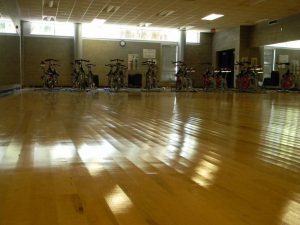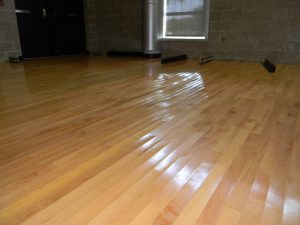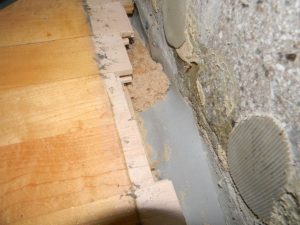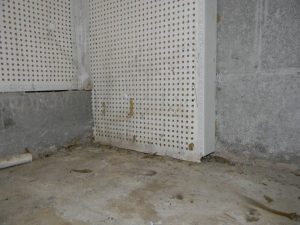U.S. Forensic was hired to perform a moisture source evaluation of buckled and cupped floors in a recreation and fitness facility. Mr. William Janowsky, P.E. was retained to complete the assignment. He obtained his Masters degree in Civil Engineering from Tulane University and his Bachelors Degree from the University of New Orleans. He is a registered professional engineer in civil engineering in numerous states.
Case Background
The facility manager reported that the recreation facility was constructed in 2002 and the wood flooring in Rooms 14 and 15 were replaced in approximately 2007 in connection with damage sustained from Hurricane Katrina. They had not experienced problems with the new flooring up until this point. No repairs or modifications were made since its installation.
The facility manager reports that in April they found water on the floors in rooms 14, 15, 19, and 29 of the building and that the next day, they discovered that the condensate drain line for the air conditioning system equipment located in room 29 of the building was clogged and overflowing onto the floor. The manager reported that staff cleared the clogged line, that the water was cleaned up, and that fans were placed in each room to increase air movement and drying. In approximately the first week of May, they noticed that the wood flooring in rooms 14 and 15 was cupped and buckled and that the condition of the wood flooring had progressively worsened thereafter. The manager stated that the base trim was removed from the walls in rooms 14 and 15, but that no repairs were performed to the flooring prior to the U.S. Forensic inspection.
Moisture Source Evaluation
The building was a 2-story indoor exercise and recreation building structure supported on a concrete slab foundation system. The exterior walls of the building were constructed of concrete masonry unit (CMU) blocks with clay brick veneer.
At the property, the engineer observed that the wood strip flooring throughout rooms 14 and 15 was cupped, and some isolated buckled areas of flooring were present in the northwest portion of room 14 and along the north end of the east wall of room 15. The conditions were consistent with expansion of the wood material from absorption of moisture. Readings taken with an electronic relative moisture meter indicated that the moisture content of the wood flooring was moderately elevated throughout rooms 14 and 15 and was highly elevated in the 2 buckled areas noted above. Mr. Janowsky measured the temperature, relative humidity, dew point temperature, and wet bulb temperature outside the building and at several locations within the building interior. The results of the measurements taken are noted in the following table:
| Location | Temperature(Degrees F) | RelativeHumidity (%) | Dew Point(Degrees F) | Wet Bulb(Degrees F) |
| Exterior | 85 | 82 | 75 | 77 |
| Interior, Lobby | 72 | 59 | 59 | 65 |
| Interior, Upper Level | 71 | 62 | 58 | 64 |
| Interior, Room 14 | 68 | 64 | 58 | 63 |
| Interior, Room 15 | 69 | 66 | 58 | 63 |
| Interior, Room 29 | 77 | 84 | 72 | 73 |
The wood strip flooring in rooms 14 and 15 was reportedly installed in 2007 and exhibited no stains or discoloration indicative of multiple or repeated wettings over an extended period. Further, examination of the flooring section revealed that a layer of plastic moisture barrier material was installed between the concrete subfloor and the floor underlayment layers in rooms 14 and 15 consistent with best installation practices for wood flooring. The temperature and humidity readings taken within the building revealed no elevated humidity levels or unique conditions in rooms 14 and 15. Accordingly, there was no evidence to indicate or suggest any long-term moisture intrusion through the foundation of the building or any on-going elevated humidity levels in rooms 14 and 15 of the building.
Review of available weather information indicated that no rainfall was recorded in the region a week before or during the time frame when the damage was discovered, and no soil deposits or residue was observed on the subfloor or walls along the north side of either room indicative of surface water intrusion from the exterior.
The condensate drain line for the air conditioner system was located in room 29, adjacent to the north end of the east wall of room 15. The drain line was reportedly found to be clogged on April 9th, and we observed moisture stains on the walls and contents in rooms 29 and 19 that were measured to be up to 6 inches above the floor surface. Measurements with an electronic moisture meter revealed highly elevated moisture levels in the wood flooring in the northeast corner of room 15 that corresponded directly with the location of the condensate drain. Relative elevation measurements on the floor surfaces in room 14 and 15 indicated that the floors generally sloped downwards to the west and south from the northeast corner of room 15 and the elevated moisture levels in the wood flooring were found to occur consistently in the lowest areas of the floor indicating that the water followed the contours of the subfloor, and collected in the lowest regions.
The available evidence indicated that water from the overflowing air conditioning condensate drain flowed from room 29 into room 15 and then entered the interior of the floor system and flowed between the plastic moisture barrier layer and the floor surface to the lowest areas of the floor in rooms 15 and 14. The physical evidence indicated that the cupped and buckled wood strip flooring in rooms 14 and 15 of the building was the result of expansion of the wood flooring material from recent exposure to moisture from the isolated overflow of a clogged condensate drain line in room 29 of the building.
Conclusions
- The physical evidence observed and measured at the property indicated that the cupped and buckled wood strip flooring in rooms 14 and 15 of the building was the result of expansion of the wood flooring material from recent exposure to moisture from the isolated overflow of a clogged air conditioning system condensate drain line in room 29 of the building.
- The configuration of the flooring system prevents exterior moisture vapor from entering the wood flooring through the foundation slab or the surface of the floor but does not prevent liquid water from entering the sides of the flooring system along the wall interfaces. However, the moisture barrier layer and surface coating traps moisture within the flooring, preventing effective drying of the floor system once it is wet. Therefore, in order to effectively repair the damage to the wood strip flooring in rooms 14 and 15 of the subject building, we recommend that the wood strip flooring, wood underlayment layers, and plastic vapor barrier material be removed and replaced with similar materials.
Photographs
- View of the north side of the recreation facility
- View of the lobby area of the building and the entrance to rooms 14 and 15
- View of cupped wood strip flooring within the interior of the room 15
- View of the edge of the floor in room 15. Note the plastic moisture barrier material, two layers of plywood and the upper layer of tongue and groove wood flooring
- View along the east wall in room 15. Note the gap between the wall and the flooring
- View of cupped wood strip flooring within the interior of the room 14
- Close up view of cupped and buckled wood strip flooring within the interior of the room 14
- View along the edge of the floor in room 14. Note the fiberboard material between the plastic moisture barrier material and the plywood underlayment
- View of the northwest corner of room 15. Note that the wood strip flooring is in contact with the wall
- View within room 29 facing south
- View of moisture stains on the lower portion of the wall on the north side of room 29
- View of moisture stains on the lower reaches of a box in room 19
Moisture Source Evaluations and More
For more information about these and other moisture related services, you may visit our services page. Visit www.usforensic.com to view our full line of forensic services and list of locations.












